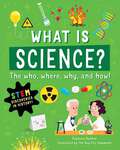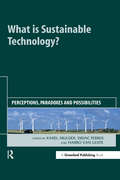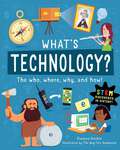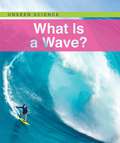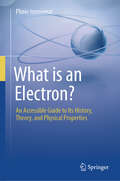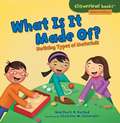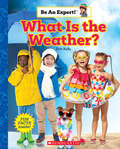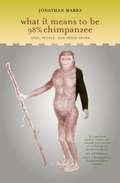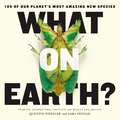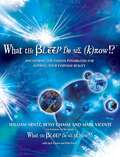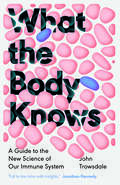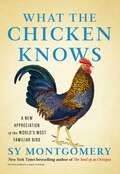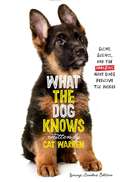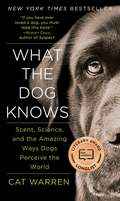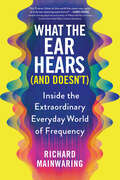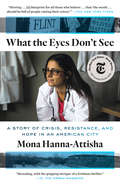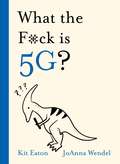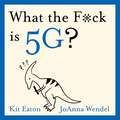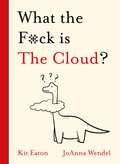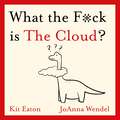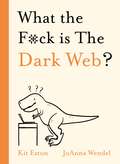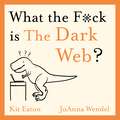- Table View
- List View
What is Science?: The Who, Where, Why, and How
by Frances DurkinFact-filled non-fiction that uncovers the who, where, why, and how of amazing scientific discoveries throughout history.From the explosion at the start of the universe to atomic energy and the impact of immunization the contents focus on the people behind the science and the history happening at the time. Included within the book is a contents list at the front and a glossary at the back plus a "take it further" activity on each page. Discover the human side of STEM!
What is Sustainable Technology?: Perceptions, Paradoxes and Possibilities
by Karel Mulder Didac Ferrer Harro van LenteDesigners of technology have a major responsibility in the current age. Their designs can have tremendous effects on society, in both the short and the long term. In fact, sustainable development itself has all the characteristics of a design project, albeit a vast one. But a failed product design here will be not just be unsuccessful in the market – it will have far-reaching consequences. It is our common responsibility to make the project successful. Technology has played an important role in creating the problems that we now face; but it will also play an important role in solving them. But this does not mean the technological fix will be easy. How do we allocate resources and attention when there are myriad issues under the umbrella of "sustainable development" currently in competition with one another? How do we arrive at precise specifications for the sustainable technologies that are to be developed and, furthermore, reach consensus on these specifications? What if our sustainable technological solutions aggravate other problems or create new ones? And, because sustainable development is all about the long-term consequences of our actions, how do we assess the effects of modifying existing landscapes, infrastructures and patterns of life?How could we be sure in advance that the changes that new technologies bring will make our society more sustainable? These dilemmas and paradoxes are the subject of this provocative book. Sometimes the claim that a technology is sustainable is made in order to make the technology acceptable in the political process, as in the case of nuclear energy production, where the claims of "sustainability" refer to the absence of CO2 emissions. In the case of biofuels, claims of sustainability have led to a "fuel or food" debate, showing that sustainability has counteracting articulations. And the well-known rebound effect is observed when increased resource efficiency can create a stimulus for consumption. What is Sustainable Technology? illustrates that the sustainability impact of a technology is often much more complicated and ambivalent than one might expect. Making improvements to existing designs is not the technological challenge that will lead to real solutions. We mustn't look to change a part of a machine, but rather the machine as a whole – or even the whole system in which it functions. It is these system innovations that have the potential to make a genuine contribution to sustainable development. What is Sustainable Technology? will help all those involved in designing more sustainable technologies in determining their strategies. It does so by presenting case studies of different technologies in contrasting contexts. Each case asks: 1. What articulations of sustainability played a role in the design process? 2. What sustainability effects did this technology lead to? 3. Who was affected, where, and when? 4. Could the designer have foreseen these consequences? 5. How did the designer anticipate them? 6. How was societal interaction dealt with during the design process? Finally, the authors reflect on future options for the sustainable technology designer. They argue that an important first step is an awareness of the multitude of sustainable development challenges that play a role in production, use, recycling and end-of-life disposal. What is Sustainable Technology? will be essential reading for product designers, engineers, material scientists and others involved in the development of sustainable technologies, as well as a wide academic audience interested in the complexities of the sustainable design process.
What is Technology?: The Who, Where, Why, and How
by Frances DurkinFact-filled non-fiction that uncovers the who where why and how of amazing technological inventions throughout history. From the magic of making music to lightbulb moments and tiny technology the contents focus on the people behind the inventions and the history happening at the time. There is a contents list at the front of the book and a glossary at the back plus a "take it further" activity on each page. Discover the human side of STEM!
What is a Wave? (Unseen Science)
by Linda IvancicWhat Is a Wave? introduces readers to the science behind that question, explaining the physics behind the phenomenon through graphs and activities. Easy-to-understand summaries following each chapter highlights the most important points for review.
What is an Electron?: An Accessible Guide to Its History, Theory, and Physical Properties
by Plinio InnocenziThis book offers an in-depth exploration of one of the fundamental particles that has shaped our understanding of the physical world and revolutionized technology, combining historical narrative with rigorous scientific analysis to provide a comprehensive account of the electron. Starting from the early atomic models of Democritus and Dalton, the book traces the journey through key experiments such as J.J. Thomson's discovery of the electron, Rutherford's model, and Bohr's contributions. It discusses how these foundational experiments and theories have paved the way for modern quantum mechanics. Each chapter looks at significant milestones, from the photoelectric effect and the discovery of electron spin to quantum tunneling and entanglement. The book also addresses the electron’s strange properties and its relatives, such as positrons, muons, and tau particles, providing a detailed examination of their roles in the broader context of quantum field theory. The author draws from original sources to ensure accuracy and authenticity, making this work a reliable reference for students and enthusiasts alike. The text is written in accessible language, carefully explaining complex concepts without overwhelming the reader with intricate mathematical formulations. With many illustrative figures, "What is an Electron?" serves as an essential resource for undergraduate students in physics, chemistry, and materials science, as well as for scientifically-curious readers eager to understand the profound implications of electron behavior in quantum mechanics and modern technology.
What is it made of: Noticing Types of Materials
by Martha E. H. RustadListening and Exploration: Helping Clients Identify Their Experiences, Issues, and Problems; Clarification: Helping Clients Clarify Their Experiences and Develop Goals; Action: Helping Clients Take Action; Effective Communication: Facilitating Exploration, Clarification, and Action.
What is the Weather? (Be an Expert!)
by Erin KellyKids love to be the experts! Now they can feel like real pros with this exciting nonfiction series for beginning readers. Kids will be hooked on the thrilling real-world topics and big, bright photos. Each book features simple sentences and sight words that children can practice reading. Then, with support, kids can dig deeper into the extra facts, Q&As, and fun challenges.Fans of this series will be eager to become real experts!Sometimes it is cold outside. We have to bundle up. Sometimes it is hot. We don’t even need a coat. The weather is always changing! What do you know about days that are sunny, cold, rainy, or dry? With this book you can become an expert!
What it Means to be 98% Chimpanzee: Apes, People and Their Genes
by Jonathan MarksA molecular anthropologist explores the production of knowledge claims about genetics, especially as they relate to inter-species similarities and race.
What on Earth?: 100 of Our Planet's Most Amazing New Species
by Quentin Wheeler Sara PennakA chameleon so tiny it can fit on your thumbnail? A spider named after David Bowie? A fungus that turns ants into zombies? What on Earth? What on Earth? is a compendium of the 100 coolest, weirdest, and most intriguing new species of this century as determined by the International Institute for Species Exploration. From animals to plants, fossils to bacteria, What on Earth? is an accessible, informative, and offbeat look at the creatures that also call our planet home, including:• A dangerous cobra that can spit its venom almost ten feet • A miniscule orchid that is less than a half-inch wide • A rainforest mushroom named after the cartoon character Spongebob Squarepants • A beautiful seahorse that changes colors to protect itself from predators • A stick insect that is as long as a man&’s arm Featuring visually striking images alongside surprising facts about each new species, What on Earth? is a testament to the incredible and ever-evolving diversity of our planet.
What the Bleep Do We Know!?™: Discovering the Endless Possibilities for Altering Your Everyday Reality
by Betsy Chasse William Arntz Mark VicenteDo you want to take a trip down the rabbit hole? Get ready, because that’s exactly what you’ll do when you open this book! Never before has a self-help book so dramatically altered the status quo—or reality for that matter. With a genre-busting breakthrough format and layout, the graphics, colors and concepts compel readers to ask themselves Great Questions that will recreate their lives as they know them. With the help of 14 leading quantum physicists, scientist and spiritual thinkers, this book guides readers on a course from the scientific to the spiritual, from the universals to the deeply personal. Along the way, it asks such questions as: Are we seeing the world as it really is? What are thoughts made of? What is the relationship between our thoughts and our world? Are we biologically addicted to certain emotions? Can I create my ideal day every day? The answer to the last question is a resounding yes: you are an infinite set of possibilities, and you can choose every day which reality you want to create for yourself. This book shows you how. Oversized hardcover! Full-color throughout! Active page design feauturing boxes, pull-outs and exercises! More than 50 movie stills, photos and illustrations! New interviews and theories! More than 30 short chapters! In this book a unique synergy is achieved between the interactive format, full-color graphics and the ability to take the complicated, dense material of mysticism, philosophy and quantum physics and boil it down to easy to understand, practical advice. What the Bleep Do We Know!? is the self-help phenomena millions have been waiting for. Key Features Forget your boring self-help books. This book has a different size, feel and look than anything else on the shelf. Uses the graphics, style, feel and basic structure of the phenomenal movie. Short chapters will be easy to understand and digest. Concise 30-step journey from the theoretic (quantum physics) to the personal (how to“create your day”). Practical exercises show how complex theories interact with daily life.
What the Body Knows: A Guide to the New Science of Our Immune System
by John TrowsdaleA leading scientist&’s guide to the way our immune system protects us—but only most of the time What is our immune system, and how does it work? A vast array of cells, proteins and chemicals spring into action whenever our bodies are damaged, but immunity is not something you can see, touch or feel. It can fight off malicious bacteria and viruses, locate cancerous growths, and even re-wire our brains – but sometimes our own tissues can get caught in its crossfire, with catastrophic consequences. Humans may be the most disease-ridden animals on the planet. Professor John Trowsdale shows how the immune system protects us, and how our bodies invest huge resources to keep it running. Immunity influences how we age, and controls how we learn to fight off recurring diseases, and how our bodies respond to chronic conditions such as heart disease and dementia. But, in the case of allergies and autoimmune conditions, it can also easily get things wrong. What the Body Knows is a hugely readable account of a fascinating phenomenon—one which, for good or for ill, impacts every aspect of our lives.
What the Chicken Knows: A New Appreciation of the World's Most Familiar Bird
by Sy MontgomeryA charming and eye-opening exploration of the special relationship between humans and chickens from Sy Montgomery, &“one of our finest chroniclers of the natural world&” (The New York Times). For more than two decades, Sy Montgomery—whose The Soul of an Octopus was a National Book Award finalist—has kept a flock of chickens in her backyard. Each chicken has an individual personality (outgoing or shy, loud or quiet, reckless or cautious) and connects with Sy in her own way. In this short, delightful book, Sy takes us inside the flock and reveals all the things that make chickens such remarkable creatures: only hours after leaving the egg, they are able to walk, run, and peck; relationships are important to them and the average chicken can recognize more than one hundred other chickens; they remember the past and anticipate the future; and they communicate specific information through at least twenty-four distinct calls. Visitors to her home are astonished by all this, but for Sy what&’s more astonishing is how little most people know about chickens, especially considering there are about twenty percent more chickens on earth than people. With a winning combination of personal narrative and science, What the Chicken Knows is exactly the kind of book that has made Sy Montgomery such a beloved and popular author.
What the Dog Knows Young Readers Edition: Scent, Science, and the Amazing Ways Dogs Perceive the World
by Cat WarrenIn this young readers edition of the New York Times bestseller, Cat Warren and her canine companion, Solo, teach readers that the nose knows no bounds when it comes to working together, being persistent, and helping others. <P><P>Solo has a fine nose and knows how to use it, but he’s only one of many thousands of scent-detection dogs all over the United States. That’s a group that includes cadaver dogs, tracking, trailing, and apprehension dogs; dogs that can locate unmarked graves of Civil War soldiers; and even dogs that can find drowning victims more than two hundred feet below the surface of a lake. All these dogs love to use their noses. They think their job is simply the best, most interesting game they’ve ever played! <P><P>What good working dogs can do may seem magical or mysterious, but What the Dog Knows shows the science, the rigorous training, and the skilled handling that underlie these amazing abilities.
What the Dog Knows: The Science and Wonder of Working Dogs
by Cat WarrenA firsthand exploration of the extraordinary abilities and surprising, sometimes life-saving talents of “working dogs”—pups who can sniff out drugs, find explosives, even locate the dead—as told through the experiences of a journalist and her intrepid canine companion, which The New York Times calls “a fascinating, deeply reported journey into the…amazing things dogs can do with their noses.”There are thousands of working dogs all over the US and beyond with incredible abilities—they can find missing people, detect drugs and bombs, pinpoint unmarked graves of Civil War soldiers, or even find drowning victims more than two hundred feet below the surface of a lake. These abilities may seem magical or mysterious, but author Cat Warren shows the science, the rigorous training, and the skilled handling that underlie these creatures’ amazing abilities. Cat Warren is a university professor and journalist who had tried everything she could think of to harness her dog Solo’s boundless energy and enthusiasm…until a behavior coach suggested she try training him to be a “working dog.” What started out as a hobby soon became a calling, as Warren was introduced to the hidden universe of dogs who do this essential work and the handlers who train them. Her dog Solo has a fine nose and knows how to use it, but he’s only one of many astounding dogs in a varied field. Warren interviews cognitive psychologists, historians, medical examiners, epidemiologists, and forensic anthropologists, as well as the breeders, trainers, and handlers who work with and rely on these intelligent and adaptable animals daily. Along the way, Warren discovers story after story that prove the capabilities—as well as the very real limits—of working dogs and their human partners. Clear-eyed and unsentimental, Warren explains why our partnership with working dogs is woven into the fabric of society, and why we keep finding new uses for the wonderful noses of our four-legged friends.
What the Ear Hears (And Doesn't): Inside the Extraordinary Everyday World of Frequency
by Richard Mainwaring"You'll never listen to the world the same way again. A truly ear-opening experience!" —Chris Ferrie, award-winning physicist and author of Where Did the Universe Come From? And Other Cosmic QuestionsFor readers of Neil deGrasse Tyson and Bill O'Neill, What the Ear Hears (and Doesn't) is a fascinating science book for adults that explores the physics principle of frequency and the (sometimes weird) role it plays in our everyday lives.What do the world's loneliest whale, a black hole, and twenty-three people doing Tae Bo all have in common?In 2011, a skyscraper in South Korea began to shake uncontrollably without warning and was immediately evacuated. Was it an earthquake? An attack? No one seemed quite sure. The actual cause emerged later and is utterly fascinating: Twenty-three middle-aged folks were having a Tae Bo fitness class in the office gym on the twelfth floor. Their beats had inadvertently matched the building's natural frequency, and this coincidence—harnessing a basic principle of physics—caused the building to shake at an alarming rate for ten minutes. Frequency is all around us, but little understood.Musician, composer, TV presenter, and educator Richard Mainwaring uses the concept of the Infinite Piano to reveal the extraordinary world of frequency in a multitude of arenas—from medicine to religion to the environment to the paranormal—through the universality of music and a range of memorable human (and animal) stories laced with dry humor. Whether you're science curious, musically inclined, or just want to know what a Szechuan pepper has to do with physics, What the Ear Hears (and Doesn't) is an immensely enjoyable read filled with "did you know?" trivia you'll love to share with friends.
What the Eyes Don't See: A Story of Crisis, Resistance, and Hope in an American City
by Mona Hanna-AttishaFlint was already a troubled city in 2014 when the state of Michigan—in the name of austerity—shifted the source of its water supply from Lake Huron to the Flint River. Soon after, citizens began complaining about the water that flowed from their taps—but officials rebuffed them, insisting that the water was fine. Dr. Mona Hanna-Attisha, a pediatrician at the city’s public hospital, took state officials at their word and encouraged the parents and children in her care to continue drinking the water—after all, it was American tap water, blessed with the state’s seal of approval. <p><p> But a conversation at a cookout with an old friend, leaked documents from a rogue environmental inspector, and the activism of a concerned mother raised red flags about lead—a neurotoxin whose irreversible effects fall most heavily on children. Even as circumstantial evidence mounted and protests grew, Dr. Mona knew that the only thing that could stop the lead poisoning was undeniable proof—and that to get it, she’d have to enter the fight of her life. <p> What the Eyes Don’t See is the inspiring story of how Dr. Mona—accompanied by an idiosyncratic team of researchers, parents, friends, and community leaders—proved that Flint’s kids were exposed to lead and then fought her own government and a brutal backlash to expose that truth to the world. Paced like a scientific thriller, this book shows how misguided austerity policies, the withdrawal of democratic government, and callous bureaucratic indifference placed an entire city at risk. And at the center of the story is Dr. Mona herself—an immigrant, doctor, scientist, and mother whose family’s activist roots inspired her pursuit of justice. <p> What the Eyes Don’t See is a riveting, beautifully rendered account of a shameful disaster that became a tale of hope, the story of a city on the ropes that came together to fight for justice, self-determination, and the right to build a better world for their—and all of our—children.
What the F*ck is 5G? (WTF Series)
by Kit EatonWhat the f*ck is 5G, and how does it even work?The world loves 4G phones, tablets and other gizmos and we take the tech for granted...but when that 4 grew up into the next-gen 5, it seems everyone perked up and started caring about phone networking tech. Journalists journaled, politicians, er, politicked, and tin-foil hat wearers reached for the extra-thick reinforced foil. Why all this fuss? Believe it or not, 5G could change the way you live. Because though it seems like smartphones are only good for tiktok and texting, 5G has the power to revolutionise how we interact with public spaces - from concerts and gigs to coffee shops, paving the way for foundational tech like virtual and augmented reality. This book will explain this missing radio link that will propel us into the future of self-driving cars and VR. Oh, and along the way we'll explore why 5G and coronavirus are very definitely and completely, utterly, not the same thing
What the F*ck is 5G? (What the *&%^)
by Kit EatonWhat the f*ck is 5G, and how does it even work?The world loves 4G phones, tablets and other gizmos and we take the tech for granted...but when that 4 grew up into the next-gen 5, it seems everyone perked up and started caring about phone networking tech. Journalists journaled, politicians, er, politicked, and tin-foil hat wearers reached for the extra-thick reinforced foil. Why all this fuss? Believe it or not, 5G could change the way you live. Because though it seems like smartphones are only good for tiktok and texting, 5G has the power to revolutionise how we interact with public spaces - from concerts and gigs to coffee shops, paving the way for foundational tech like virtual and augmented reality. This book will explain this missing radio link that will propel us into the future of self-driving cars and VR. Oh, and along the way we'll explore why 5G and coronavirus are very definitely and completely, utterly, not the same thing
What the F*ck is 5G? (What the *&%^)
by Kit EatonWhat the f*ck is 5G and how does it work?The world loves 4G phones, tablets and other gizmos and we take the tech for granted...but when that 4 grew up into the next-gen 5, it seems everyone perked up and started caring about phone networking tech. Journalists journaled, politicians, er, politicked, and tin-foil hat wearers reached for the extra-thick reinforced foil. Why all this fuss? Believe it or not, 5G could change the way you live. Because though it seems like smartphones are only good for tiktok and texting, 5G has the power to revolutionise how we interact with public spaces - from concerts and gigs to coffee shops, paving the way for foundational tech like virtual and augmented reality. This book will explain this missing radio link that will propel us into the future of self-driving cars and VR. Oh, and along the way we'll explore why 5G and coronavirus are very definitely and completely, utterly, not the same thing.(P) 2021 Hodder & Stoughton Ltd
What the F*ck is The Cloud? (WTF Series)
by Kit EatonWhat the f*ck is the Cloud, and how does it even work?Ah, The Cloud. It's such a useful bit of tech jargon isn't it? The kind that's casually thrown around in work meetings by bosses who (kind of) understand and maybe even at the nerdier type of dinner or drinks parties. People joke about the cloud while others take it for granted and some worry about this mysterious entity where all of our data is stored, accessible at the touch of a screen from anywhere on Earth. But what even is the cloud, and for that matter, where is the cloud?Join us on a journey from the very first iterations of the internet that we know and (sometimes) love, all the way through thorny issues of data collection and storage (weren't we all fooled by the 'ten years on' social media trend, even as we rely on cloud-stored photos of cats to cheer us up?) and discover the mysterious place where The Cloud ominously hovers.
What the F*ck is The Cloud? (WTF Series)
by Kit EatonWhat the f*ck is the Cloud, and how does it even work?Ah, The Cloud. It's such a useful bit of tech jargon isn't it? The kind that's casually thrown around in work meetings by bosses who (kind of) understand and maybe even at the nerdier type of dinner or drinks parties. People joke about the cloud while others take it for granted and some worry about this mysterious entity where all of our data is stored, accessible at the touch of a screen from anywhere on Earth. But what even is the cloud, and for that matter, where is the cloud?Join us on a journey from the very first iterations of the internet that we know and (sometimes) love, all the way through thorny issues of data collection and storage (weren't we all fooled by the 'ten years on' social media trend, even as we rely on cloud-stored photos of cats to cheer us up?) and discover the mysterious place where The Cloud ominously hovers.
What the F*ck is The Cloud? (WTF Series)
by Kit EatonWhat the f*ck is the the Cloud and how does it work?Ah, The Cloud. It's such a useful bit of tech jargon isn't it? The kind that's casually thrown around in work meetings by bosses who (kind of) understand and maybe even at the nerdier type of dinner or drinks parties. People joke about the cloud while others take it for granted and some worry about this mysterious entity where all of our data is stored, accessible at the touch of a screen from anywhere on Earth. But what even is the cloud, and for that matter, where is the cloud?Join us on a journey from the very first iterations of the internet that we know and (sometimes) love, all the way through thorny issues of data collection and storage (weren't we all fooled by the 'ten years on' social media trend, even as we rely on cloud-stored photos of cats to cheer us up?) and discover the mysterious place where The Cloud ominously hovers.(P) 2021 Hodder & Stoughton Ltd
What the F*ck is The Dark Web? (WTF Series)
by Kit EatonWhat the f*ck is the Dark Web, and how does it even work?Whether it's from dodgy acronym-titled crime shows to news stories designed to terrify you down to your socks we've all heard about sites like Silk Road and the ways criminals use cryptocurrency online. But did you know that among the various shady corners of the dark web you can also find portals to the BBC and Facebook?The thing is even the way the everyday internet works is a mystery to us and its darkest corners are, of course, more deeply shrouded. So, let's go on a journey from the birth of the Net through the strangest dark services - need a hitman to bump off your superfluous...er...beloved spouse? - to the surprisingly positive uses of dark technology, including dodging the watchful eye of oppressive censors.Over half of us can't remember a time before the internet - and for the rest it's increasingly difficult to imagine life without the damn thing! It's about time we understood more about it and we can start with the question: What The Fuck is The Dark Web?
What the F*ck is The Dark Web? (WTF Series)
by Kit EatonWhat the f*ck is the Dark Web, and how does it even work?Whether it's from dodgy acronym-titled crime shows to news stories designed to terrify you down to your socks we've all heard about sites like Silk Road and the ways criminals use cryptocurrency online. But did you know that among the various shady corners of the dark web you can also find portals to the BBC and Facebook?The thing is even the way the everyday internet works is a mystery to us and its darkest corners are, of course, more deeply shrouded. So, let's go on a journey from the birth of the Net through the strangest dark services - need a hitman to bump off your superfluous...er...beloved spouse? - to the surprisingly positive uses of dark technology, including dodging the watchful eye of oppressive censors.Over half of us can't remember a time before the internet - and for the rest it's increasingly difficult to imagine life without the damn thing! It's about time we understood more about it and we can start with the question: What The Fuck is The Dark Web?
What the F*ck is The Dark Web? (WTF Series)
by Kit EatonWhat the f*ck is the dark web and how does it work?Whether it's from dodgy acronym-titled crime shows to news stories designed to terrify you down to your socks we've all heard about sites like Silk Road and the ways criminals use cryptocurrency online. But did you know that among the various shady corners of the dark web you can also find portals to the BBC and Facebook?The thing is even the way the everyday internet works is a mystery to us and its darkest corners are, of course, more deeply shrouded. So, let's go on a journey from the birth of the Net through the strangest dark services - need a hitman to bump off your superfluous...er...beloved spouse? - to the surprisingly positive uses of dark technology, including dodging the watchful eye of oppressive censors.Over half of us can't remember a time before the internet - and for the rest it's increasingly difficult to imagine life without the damn thing! It's about time we understood more about it and we can start with the question: What The Fuck is The Dark Web?
